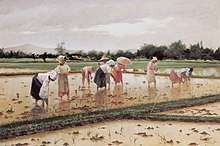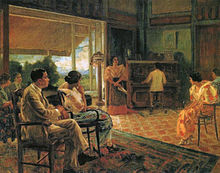Fabián de la Rosa
Don Fabián de la Rosa y Cueto (May 5, 1869 – December 14, 1937) was a Filipino painter. He was the uncle and mentor to the Philippines' national artist in painting, Fernando Amorsolo, and to his brother Pablo.[1] He is regarded as a "master of genre" in Philippine art. [2][3][4][5][6]

Early life and education[edit]
Fabián de la Rosa was born in Paco, Manila to husband and wife Marcos de la Rosa and Gorgonia Cueto. Born to a family of artists, he was exposed to art at an early age and learned to draw well before he could write. He was trained to sketch portraits and landscapes by his aunt, Marciana de la Rosa, when he was ten years old. He also apprenticed under his uncle, Simón Flores y de la Rosa, a well-known painter of portraits and church interiors from the nineteenth century.[7] De la Rosa lived most of his life in the Philippines and visited Europe for the first time when he was 39. He married Gorgonia Tolentino on January 13, 1900.[2][4]
Career[edit]



Academic Training[edit]
De la Rosa received formal education at the age of 12 when he enrolled at the Escuela de Artes y Oficios in 1881.[8] Three years into his training de la Rosa's father died, forcing the young painter to drop out of the school in order to help feed his family. It was during this time that he painted his first known masterpiece, La Perla de Lucban.[9] In 1893, he entered the Escuela Superior de Pintura Escultura y Grabado at the age of 24 where he received training from Lorenzo Guerrero and Miguel Zaragoza. In 1898, de la Rosa won a contest for a scholarship to Spanish Art Academy of San Fernando in Madrid. However, the outbreak of the Philippine Revolution meant his dream would not materialize.[10]
Later under the American regime, the Escuela would become one of the three founding units of the University of the Philippines (established in 1908) and renamed the UP School of Fine Arts.[11] In 1908, he traveled to Europe as a pensionado through a scholarship opportunity given by the Germinal Cigar Factory. He attended the Académie Julian in Paris, France.[2][3][4][12]
As a professor[edit]

After traveling from Europe, he became one of the first instructors at the School of Fine Arts at the University of the Philippines, where he introduced to his students the decorated form of painting. De la Rosa became the full director of the school from 1927 to 1937.[2][3][4]
Exhibition[edit]
Together with his wife, de la Rosa went back to Europe in 1928, where he painted in Paris for four months. He also traveled to Munich, Germany, Geneva, Switzerland, and Rome. Upon reaching Madrid, Spain, he held an exhibit of his works at the Ateneo de Madrid.[2][4][5][6]
Reviews[edit]
It is believed that de la Rosa was able to paint about 1,000 works. De la Rosa's works were divided by Aurelio S. Alvero into three time periods: those that are academic but are not giving importance to atmosphere and ambience; those that have academic form that gives importance to the environment that could be sensed; and those that play with the use of colors.[2][4]

Works[edit]
- Women Working in a Rice Field, 1921
- Transplanting Rice, 1904
- The Death of General Lawton, 1904
- Un recuerdo de la Villa Borghese (A Remembrance of the Villa Borghese), 1909
- Planting Rice, 109.2 x 190.6 cm, oil on canvas, 1921, Malacañan Palace Collection
- Los Baños, watercolor, 56.2 x 66.4 cm, 1922, UP Vargas Museum
- La pintora (Woman Painter)
- La bordadora (The Embroiderer)
- Landscape with Dark Trees, 1927
- Barcazas en el Rio (Houseboats in a River), oil on canvas, Private Collection, USA
- Pasay Beach, Manila, 1927
- Young Filipina, oil on canvas, 34.2 x 27.9 cm, 1928, Paulino Que Collection
- El kundiman (The Kundiman), 1930
- Riverview of Sta. Ana, 48.2 x 64.5 cm, oil on canvas, 1938, UP Vargas Museum Collection
- Marikina Road, ca. 1939
- View of Santa Ana
- Marikina Valley, oil on canvas, 39.3 x 50 cm, undated, UP Vargas Museum Collection
- El Kabayo 48.2 x 64.5 cm, oil on canvas, 1938, UP Vargas Museum Collection
Awards[edit]
Even after his death, de la Rosa was recognized and was given the Patnubay ng Sining at Kalinangan (Guide of the Arts and Culture) by the City of Manila in 1968.[2][4]
De la Rosa's Transplanting Rice received the golden award at the International Exposition held in St. Louis, Missouri in 1904. It is also during this exposition when his The Death of General Lawton was awarded the bronze prize.[2][4]
An exposition about the paintings of de la Rosa was held at the Jorge B. Vargas Museum of the University of the Philippines, in Diliman, Quezon City, on January 14, 2007. The presentation was given the title "Fabian De la Rosa (1869-1938) Retrospective Exhibition," and was managed by the University of the Philippines with the assistance of the Spanish Program for Cultural Cooperation and Filipiniana.net, a part of Vibal Publishing House, Inc.[1][4][13][14]
See also[edit]
- Justiniano Asuncion
- José Honorato Lozano
- Damián Domingo
- Fernando Amorsolo
- Juan Luna
- Félix Resurrección Hidalgo
References[edit]
- ^ a b Fabian dela Rosa: Retrospective Exhibition, Vargas Museum, University of the Philippines, VargasMuseum.org, 2006 Archived 2007-11-02 at the Wayback Machine, retrieved on: April 7, 2008
- ^ a b c d e f g h Fabian Cueto de la Rosa, GeringerArt.com (undated) Archived 2008-04-30 at the Wayback Machine, retrieved on March 18, 2008
- ^ a b c Hernandez, Eloisa May P., Fabian de la Rosa, The American and Contemporary Traditions in Philippine Visual Arts, NCCA.gov Archived 2008-04-16 at the Wayback Machine, retrieved on: April 7, 2008
- ^ a b c d e f g h i De la Paz, Christiane. Master of Genre: Fabian Cueto dela Rosa (1869-1937), The Arts of the Philippines/Artes de las Filipinas, 2005, retrieved on April 7, 2008
- ^ a b Fabián de la Rosa Book Launch and Short Film Premiere, Fabián de la Rosa Book Launch and Short Film Premiere A Night of Discovery, Nostalgia, and Filipino Pride Archived 2008-03-15 at the Wayback Machine, Filipiniana.net News and Current Affairs, Filipiniana.net; "Fabián de la Rosa (1869-1937) was, much less that he served as the first Filipino dean of the 100-year-old art institution, or that he was not merely the uncle of celebrated National Artist Fernando Amorsolo, but he made his own mark in the international art scene as gold medal winner in the 1904 World's Fair in St. Louis, Missouri"; "When the documentary was shown, many felt the swelling of Filipino pride on finding out that the 20th century master – though overshadowed by the fame of his predecessors Juan Luna and Felix Resurreccion Hidalgo – was hailed by international critics as one of the greatest Filipino artists of all time...", retrieved on: April 14, 2008
- ^ a b 1901-1940: A Moving Legacy… Archived 2008-02-15 at the Wayback Machine, NCCA.gov, "In 1904, the Philippine Commission sent a delegation of 50 Filipino Commissioners to the Louisiana Purchase Expo or World Fair at St. Louis, Missouri USA. Native Filipinos along with an exhibit of Philippine products and replicas of ethnic villages were displayed at the said exposition... The introduction of American culture brought about the sudden modernization in Filipino cities, especially Manila. And with these changes, artists turned their attention anew to what was characteristic of the Philippines. Fabián de la Rosa and Fernando Amorsolo, two genre painters, formed the mainstream of Philippine art in the first quarter of the twentieth century..."; retrieved on: April 14, 2008
- ^ Duldulao, Manuel (1992). A Century of Realism in Philippine Art. Quezon City: Legacy Publishers. p. 26.
- ^ Pilar, Santiago (2007). Labrador, Ana (ed.). Fabian de la Rosa and His Times. Quezon City: Vibal Publishing House. p. 74.
- ^ Santiago, Luciano (2007). Labrador, Ana (ed.). Fabian de la Rosa and His Times. Quezon City: Vibal Publishing House. p. 9.
- ^ Santiago, Luciano (2007). Labrador, Ana (ed.). Fabian de la Rosa and His Times. Quezon City: Vibal Publishing House. p. 11.
- ^ "History". College of Fine Arts University of the Philippines. Archived from the original on November 8, 2021. Retrieved July 11, 2017.
- ^ (fr) Revue des Arts, 1931
- ^ De Guzman, Susan, Remembering Fabian de la Rosa, A little heralded Filipino artist gets an overdue retrospective exhibition, “Fabian De la Rosa (1869-1938) Retrospective Exhibition”, ArtSentralManila.net, 2007 Archived 2008-02-07 at the Wayback Machine, retrieved on March 19, 2008
- ^ Fabian dela Rosa: Retrospective Exhibition, Vargas Museum, University of the Philippines, Researchsea.com, September 2006, retrieved on April 7, 2008
External links[edit]
- Fabián de la Rosa's Paintings at ArtesdelasFilipinas.com
- Video Documentary on Fabian de la Rosa Premieres on YouTube, News and Current Affairs, Filipiniana.net, January 17, 2007


 French
French Deutsch
Deutsch